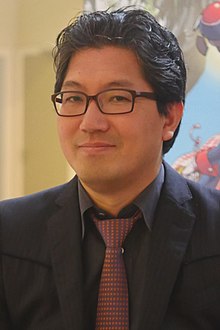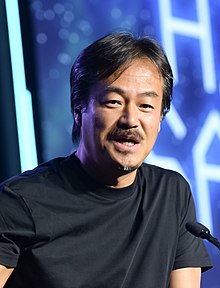Portal:Video games
The Video Games Portal

A video game, sometimes further qualified as a computer game, is an electronic game that involves interaction with a user interface or input device (such as a joystick, controller, keyboard, or motion sensing device) to generate visual feedback from a display device, most commonly shown in a video format on a television set, computer monitor, flat-panel display or touchscreen on handheld devices, or a virtual reality headset. Most modern video games are audiovisual, with audio complement delivered through speakers or headphones, and sometimes also with other types of sensory feedback (e.g., haptic technology that provides tactile sensations). Some video games also allow microphone and webcam inputs for in-game chatting and livestreaming.
Video games are typically categorized according to their hardware platform, which traditionally includes arcade video games, console games, and computer games (which includes LAN games, online games, and browser games). More recently, the video game industry has expanded onto mobile gaming through mobile devices (such as smartphones and tablet computers), virtual and augmented reality systems, and remote cloud gaming. Video games are also classified into a wide range of genres based on their style of gameplay and target audience. (Full article...)
Featured articles –
Aria of Sorrow is set in the year 2035, when Dracula has been sealed away after a battle in 1999. The plot follows the journey of Soma Cruz, a teenager granted occult powers, as he battles dark figures that wish to inherit Dracula's power. The game has been described as an action-adventure game with elements of role-playing games. Aria of Sorrow introduces several features to the series, such as the "Tactical Soul" system and employs a futuristic storyline in contrast to the medieval setting of other Castlevania games.
Aria of Sorrow was released in May 2003. Although it sold poorly in Japan, selling 27,000 units nearly one month after its release, it was commercially successful in the United States, with more than 158,000 units sold in the three months following its release. Aria of Sorrow received universal acclaim, with praise for its visuals, gameplay (particularly the Tactical Soul System), music, and level design. Some critics considered it the best Castlevania game since Symphony of the Night. (Full article...)
As with its predecessor, gameplay is centred around Nights flying through the dreams of the two children. The main objective of the game is to fly through rings while gathering enough keys to proceed to the next level. Development of Journey of Dreams began shortly after the release of Shadow the Hedgehog in 2005, and was headed by Sonic Team veteran Takashi Iizuka. The team took steps to ensure that the game stayed faithful to the original, while incorporating a variety of new mechanics and features. The game's setting was designed to resemble England, especially parts of London.
Journey of Dreams received mixed reviews; critics praised the game's colourful visuals, boss battles, soundtrack, and special effects, but criticised its controls, camera, aesthetics, and aspects of its gameplay. Despite the mixed reception, Iizuka said that he would be interested in making a third Nights game, should Sega commission one. (Full article...)
Sonic Team began developing Sonic Adventure in 1997, after the cancellation of the Sega Saturn game Sonic X-treme. Led by director Takashi Iizuka and producer Yuji Naka, the team strove to reinvent Sonic for the 3D era of video games. Adventure features a stronger emphasis on storytelling and role-playing elements in contrast to previous Sonic games, while Yuji Uekawa redesigned the series's characters for their transition to 3D. Sonic Team attempted to demonstrate the technical prowess of the Dreamcast with realistic graphics and drew inspiration from locations in Peru and Guatemala. The soundtrack was primarily composed by Jun Senoue, who preferred rock music over the electropop of previous Sonic games.
Following its reveal at the Tokyo International Forum in August 1998, Sonic Adventure was highly anticipated and was released in Japan in December 1998, North America in September 1999, and Europe in October 1999. It received critical acclaim and became the Dreamcast's bestseller, with 2.5 million copies sold by August 2006. Reviewers considered Adventure a major technical advancement and praised the visuals and gameplay. Though critics noted glitches and camera problems, and reactions to the audio were mixed, they considered Sonic Adventure an exceptional game; some speculated that it could help re-establish Sega as the dominant console manufacturer after the unsuccessful Saturn. (Full article...)
After the success of BioShock, 2K Games formed a new studio, 2K Marin, to create the sequel. 2K Australia, Arkane Studios, and Digital Extremes provided additional support. The developers focused on improving gameplay elements from the first game, and return to the Rapture setting to explore a new perspective of the city. The story received major changes throughout development. Garry Schyman, who composed BioShock's soundtrack, returned for the sequel; he expanded the game's sonic palette to include more blues and religious music to parallel its themes.
BioShock 2 received positive reviews, with praise directed at its narrative, themes, art style, characters, endings and gameplay. Criticisms included a slow start and failure to distinguish itself from its predecessor. Retrospective reviews have been more positive, with some considering it the best in the series. The multiplayer mode was supported with downloadable content, and a single-player campaign expansion, Minerva's Den, released in August 2010. The game sold more than 3 million copies, but did not meet the publisher's sales expectations. A remastered version titled BioShock 2 Remastered was released as part of BioShock: The Collection for PlayStation 4, Windows, Xbox One, and Nintendo Switch. (Full article...)
The Flash version of Flow received 100,000 downloads within its first two weeks of release, and had been played over 3.5 million times by 2008. Its PlayStation 3 re-release was the most downloaded game on the PlayStation Network in 2007 and won the Best Downloadable Game award at the 2008 Game Developers Choice Awards. It was nominated for awards by the Academy of Interactive Arts & Sciences and the British Academy of Film and Television Arts (BAFTA). Reviewers praised Flow's visual and audio appeal, but noted the simplicity of its gameplay; several considered it to be more of an art piece than a game. (Full article...)
In Tatsunoko vs. Capcom, players engage in combat with a team of two characters or with a single giant character and attempt to knock out their opponents. It is the seventh Capcom-designed installment in their Vs. fighting game series, which includes the Marvel vs. Capcom and Capcom vs. SNK series, and the first to be fully rendered in 3D graphics. The game is set in a 2.5D environment; characters fight in a two-dimensional arena, but character models and backgrounds are rendered in three-dimensional graphics. The game is designed around a simplified three-button attack system, which was inspired by the simplistic control schemes commonly used by both the Vs. series and the Wii.
The game received generally positive reviews from critics, who praised its approachable gameplay for newcomers and depth for veteran players. However, reviewers had mixed experiences with its online component, and found Arcade mode lacking in replay value. According to the game's producer, Ryota Niitsuma, development difficulties and a lack of Wii fighting games were the reasons for its platform exclusivity; however, multiple critics questioned if that was the best choice. Capcom announced in April 2010 that the game was a commercial success. (Full article...)
The team sought to create an immersive world for the player and to compete with the Microsoft Flight Simulator series. Commercially, Flight Unlimited II performed well enough to recoup its development costs. Critics lauded the game's graphics and simulated airspace, and several praised its physics. However, some considered the game to be inferior to Microsoft Flight Simulator 98. Following the completion of Flight Unlimited II, its team split up to develop Flight Unlimited III (1999) and Flight Combat (later Jane's Attack Squadron) simultaneously. Both projects were troubled, and they contributed to the closure of Looking Glass in May 2000. (Full article...)
Did you know... -
- ... that before Sarah Elmaleh voiced the player character in the video game Anthem, developed by BioWare, she voiced characters in a mod of an earlier BioWare game?
- ... that the video game Manor Lords was wishlisted more than three million times on Steam after its developer had estimated it would receive around 14,000?
- ... that classified documents of the United States were partially leaked onto a Discord server for the video game Minecraft?
- ... that the illustrations in the 1992 video game Tetris Classic are based on scenes from Alexander Pushkin's poem Ruslan and Ludmila?
- ... that the video game Serious Sam: Tormental was originally inspired by Geometry Wars?
- ... that the game designer of the video game Hades said that the characters were attractive "because Jen Zee"?
- ... that a pink skin for Mercy in the video game Overwatch helped raise more than $12 million for breast cancer research?
- ... that Rawson Stovall became the first nationally syndicated video game journalist in the United States when he was only eleven years old?
- ... that fighting video game Panza Kick Boxing was endorsed by a French kickboxing champion who also supplied technical advice?
- ... that for at least 90 minutes, Mori Calliope livestreamed herself begging video game developer Atlus to allow her to stream their game Persona 3?
- ... that the contrabass trombone has experienced a revival in film music and video game soundtracks?
- ... that the 1979 video game Superman was one of the first console games with a pause feature?
Selected biography –
Selected image -
Recent video game-related events
- January 16, 2025 –
- Nintendo officially reveals the Nintendo Switch 2 video game console, the successor to the Nintendo Switch. (Nintendo)
- September 12, 2024 – 2023–2024 video game industry layoffs
- Microsoft announces that it will lay off 650 Microsoft Gaming employees as part of cuts to its workforce. (Variety)
- August 15, 2024 –
- American video game magazine Game Informer discontinues publication after 33 years. The magazine's website is also shut down. (BBC News)
Topics
Categories
Things you can do
In other Wikimedia projects
The following Wikimedia Foundation sister projects provide more on this subject:
-
Commons
Free media repository -
Wikibooks
Free textbooks and manuals -
Wikidata
Free knowledge base -
Wikinews
Free-content news -
Wikiquote
Collection of quotations -
Wikisource
Free-content library -
Wikiversity
Free learning tools -
Wiktionary
Dictionary and thesaurus













































